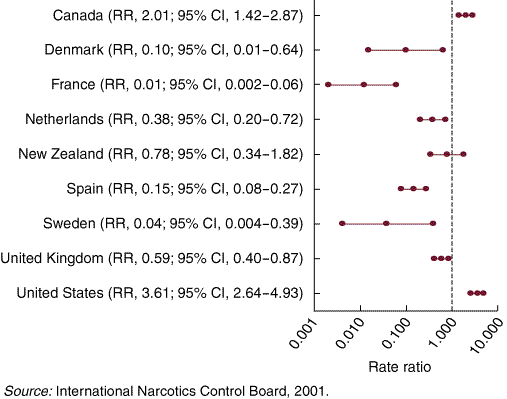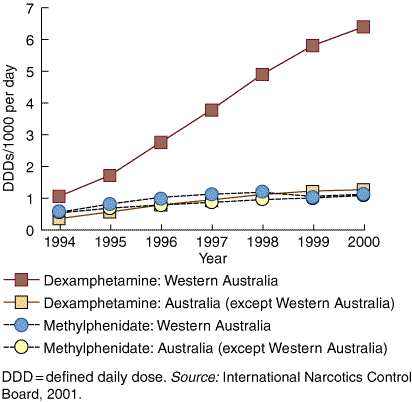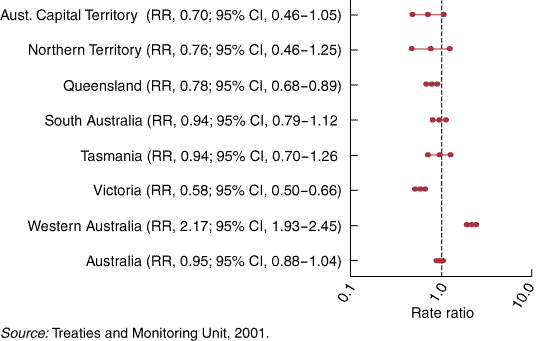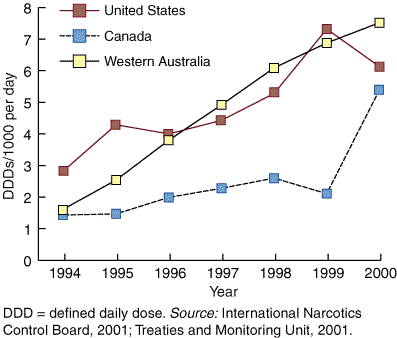Standardised data have been lacking to reliably test differences in the consumption of psychostimulants for the treatment of attention deficit hyperactivity disorder (ADHD). This study is the first standardised analysis of drug consumption data from statutory international and national sources, and forms a reference for evaluating use of these drugs.
The centrally acting psychostimulant drugs methylphenidate and dexamphetamine are the preferred pharmacotherapies for ADHD in children in North America,1 the United Kingdom2 and Australia.3 The safety of these agents used long term,1 their use in children aged under six years,4 the variable methodology in clinical trials,2,5 the sequential or combined use of drug and non-drug approaches,3,5 and misuse of these drugs6 are issues of concern. Results of large controlled studies have confirmed that psychostimulants are efficacious treatments in defined patients who are accurately diagnosed and whose treatment has been rigorously assessed.2,5
Dexamphetamine is the only psychostimulant available through Australia's Pharmaceutical Benefits Scheme (PBS). PBS prescribing of dexamphetamine requires approval in States and Territories of patients and prescribers (usually psychiatrists and paediatricians). ADHD and narcolepsy are the only approved PBS indications, with ADHD the dominant use.
Since 1990, increasingly high rates of psychostimulant prescribing to children and of doctors' consultations for ADHD have been reported in the United States and Australia.1,3,7-10 Because of its PBS listing and longer half-life, use of dexamphetamine outgrew the use of methylphenidate.11 Prescribing of these drugs in Australia is controlled by a few specialists.12
Studies on the characteristics of ADHD and psychostimulant use are difficult to compare because of the different units, varying age groups studied and differing methods used.11-14 A lack of standardisation in Australian and international studies underlies the few reported comparisons of regional8 or international12 consumption of psychostimulants and hinders the evaluation of prescribing practices and prescription drug misuse.
The aims of this study are to compare trends from 1994 to 2000 in the rates of consumption of dexamphetamine and methylphenidate in Australia with nine other developed countries, and to compare the rates of their consumption between Australia's jurisdictions (States and Territories) from 1984 to 2000.
International data on the consumption of licit drugs of dependence are held by the International Narcotics Control Board (INCB),15 which publishes yearly reports, with statistics received from about 160 member countries, including the Treaties and Monitoring Unit (TMU) in Australia's Commonwealth Department of Health and Ageing.16 The INCB and TMU are, respectively, the most reliable international and jurisdictional sources of consumption of these agents.16
Data on total yearly dexamphetamine and methylphenidate consumption for Australia and nine other developed countries from 1994 to 2000 were obtained from the INCB and standardised. Canada, Denmark, France, the Netherlands, New Zealand, Spain, Sweden, the United Kingdom and the US were selected because they are developed countries and their annual data have for many years been audited by the INCB.
Annual data from 1984 to 2000 on dexamphetamine sulfate 5 mg tablets and methylphenidate 10 mg tablets were obtained from the TMU and standardised to defined daily doses (DDDs) per 1000 population per day using interpolations of end-year national and Australian jurisdictional populations. The methods have been previously reported.16 The DDDs for dexamphetamine of 15 mg and for methylphenidate of 30 mg have been set by the World Health Organization Collaborating Centre for Drug Statistics Methodology.17
Poisson regression models18 were used for all statistical analyses of DDD rates by country and by Australian jurisdiction. Total populations for each country and jurisdiction in each calendar year were used as the denominator. The natural logarithm of the denominator was used as the offset variable in the Poisson regression analysis. Rate ratios (RRs) and their 95% confidence intervals are reported. Overall consumption rates are based on aggregates over the entire study period. Because of the overdispersion of data, a Pearson's scale factor was used. All the regression analysis was done using SAS (Proc Genmod).19
The relative risks (RRs) were calculated for each country in the international comparison and for each jurisdiction in Australia. In the international analysis, Australia was attributed a rate ratio of 1.0. In the national analysis, New South Wales was assigned a rate ratio of 1.0.
From 1994 to 2000, for the 10 countries studied, there was a significantly increased trend in consumption of dexamphetamine and methylphenidate of an average 12% per year (RR, 1.12; 95% CI, 1.09–1.38). The US consumed nearly four times the DDD/1000 population per day more than Australia, and Canada consumed twice as much as Australia and New Zealand. All other countries consumed significantly less than Australia. France, Denmark and Sweden showed low rates of consumption (Box 1).
To estimate the effect of differential age, a sensitivity analysis was carried out by studying the consumption in just the population aged 5–19 years in the 10 countries studied20 and using these figures as the denominators in the calculation of DDD. The results obtained were very similar to using the total population20 (eg, the US had an RR of 3.61 [95% CI, 2.64–4.93] using the total population, whereas using the 5–19-year-old population gave an RR of 3.55 [95% CI, 2.59–4.85]). This implies that the differences in RRs between countries cannot be explained by differences in the age distribution alone.20
Comparison of trends from 1994 to 1997 and 1998 to 2000 in the total consumption of total licit dexamphetamine and methylphenidate in all countries, excluding Canada and the US, showed an overall 87% increase in consumption for the period 1998–2000 compared with 1994–1997 (RR, 1.87; 95% CI, 1.50–2.34). For the US alone, the increase was 45% (RR, 1.45; 95% CI, 1.16–1.80) and for Canada alone the increase was 93% (RR, 1.93; 95% CI, 1.06–3.49).
From 1994 to 2000, the patterns of psychostimulant consumption differed markedly between Australia and other countries. In 1994, for example, the methylphenidate to total psychostimulant consumption was 86% for the US, 94% for Canada and 38% for Australia. In 2000, this declined to 59% in the US and 84% in Canada, and was 42% in Australia.
The trend for WA's consumption of dexamphetamine increased by an average 43% per year over the period 1984–2000 (RR, 1.43; 95% CI, 1.35–1.50), while the total consumption for all jurisdictions (excluding WA) showed an average increase of 27% per year (RR, 1.27; 95% CI, 1.22–1.31). Over the same period, average consumption of methylphenidate in WA increased by 20% per year (RR, 1.20; 95% CI, 1.16–1.25), compared with a 19% per year increase for all other jurisdictions (RR, 1.19; 95% CI, 1.15–1.22). The jurisdictional trends for the period 1994–2000 are shown in Box 2.
A comparison of trends in the consumption of dexamphetamine for the whole of Australia shows an overall 14-fold increase for the period 1994–2000 compared with 1984–1993 (RR, 13.93; 95% CI, 10.64–18.22). For methylphenidate, there was a sixfold increase in consumption for the period 1994–2000 compared with 1984–1993 (RR, 6.30; 95% CI, 5.46–7.27). The differences between jurisdictions are shown in Box 3.
From 1994 to 2000, the patterns of consumption of psychostimulants differed considerably between jurisdictions. In 1994, methylphenidate comprised 47% of total psychostimulants consumed in NSW and 35% in WA, whereas in 2000 methylphenidate comprised 44% in NSW but had fallen to 15% in WA.
From 1994 to 2000, the total licit psychostimulant consumption in the US, Canada and WA did not differ significantly (Box 4), but the annual average increase of 11% per year was highly significant (RR, 1.11; 95% CI, 1.08–1.15). The rate of consumption of total licit psychostimulants in the US was higher, but not significantly more than in WA (RR, 1.43; 95% CI, 0.49–4.16). Canada consumed less than WA, but again this was not significant (RR, 0.79; 95% CI, 0.26–2.37). For the period 1998–2000, there was a 47% increase in consumption for the US, Canada and WA (RR, 1.47; 95% CI, 1.27–1.70) compared with the period 1994–1997.
Our trend analyses form reference data for international and Australian jurisdictional comparisons of the consumption of licit psychostimulants. The advantage of standardising consumption in DDDs/1000 population per day is evident in the ability to compare the consumption of the individual or total psychostimulants between and within countries.
Our results support the findings of large increases and high levels of consumption of psychostimulants in the US and Australia using a variety of other indicators of psychostimulant consumption, such as prescriptions or tablets dispensed, visits to doctors, and regional or national surveys of young people done in many settings, including schools.1,6-14
The US's highest consumption of these agents, Canada's second, Australia's and New Zealand's equal third and the lower rankings have not been reported before. Factors contributing to high consumption in the US, in addition to different age composition, may include the ready access to a wide range of community prescribers (eg, school nurses8 and general community doctors), broader diagnostic criteria for ADHD, and prescribing standards less strict than, for example, those of the UK.2,5 An international comparison showed that consumption in Europe is relatively low but rising.9
Australia's national 1.8% point prevalence of psychostimulant consumption during 1998 in 6–17-year olds10 and NSW's point prevalence in November 2000 of 1% in those aged under 18 years14 are lower than rates in the US, but the reported differences in methodology, analyses and measures of use restrict comparisons.
WA's highest rate of consumption in Australia, with levels similar to those in the US and Canada (Box 4), requires further analysis of contributing factors and defined outcomes.
Researchers regard overtreatment of ADHD as unlikely in NSW, as the estimated 1% point prevalence of use in people younger than 18 years14 is less than the 3% or higher rates of treatment often reported in US children. It is also much less than Australia's 11.2% annual prevalence of ADHD as defined by DSM-IV criteria, equivalent to a 7.5% point prevalence of ADHD in people aged 6–17 years.7 Methodological differences between the studies, however, restrict comparisons.
UK prescribing recommendations for psychostimulants (following or in conjunction with non-drug measures)2,5 are confined to the severe combined-type of ADHD. This occurs with a point prevalence of about 1% of 6–16-year-olds, compared with Australia's 1.8% of 6–17-year-olds or the higher rates of ADHD treated in the US.2,10
The high consumption of psychostimulants in WA raises the issue of their misuse.6 Australia's Illicit Drug Reporting System reported a black market trade in illicit prescription amphetamines existed in all jurisdictions, with WA in 2001 having the highest rate (38%) in amphetamine-injecting drug users in the past six months.21 In 2000, 17 (7.8%) of 217 students aged 13–18 years in five WA government and non-government schools reported using non-medically prescribed psychostimulants in the past, mainly for non-medical reasons.22 In Canada, where the level of psychostimulant consumption is similar to WA, 8.5% of 13 549 students aged 11–19 years reported in 1998 taking non-medically prescribed psychostimulants in the previous 12 months.6
An estimated 18 000 children, or 4.2%–4.5% of WA's population aged 4–17 years in 2000, received psychostimulants for ADHD in 2000.23 This equated to yearly estimates of 12.878 million tablets of dexamphetamine and 2.190 million methylphenidate tablets.23 The Health Insurance Commission (HIC) and state pharmacy bodies have alerted community pharmacists to exercise diligence with the frequency of repeat prescriptions for dexamphetamine dispensed in a number of cases of ADHD.24
The gradual decline in methylphenidate consumption in the US may reflect a growing realisation of the pharmacokinetics and price advantages of dexamphetamine.1 In Australia, the high relative consumption of methylphenidate in NSW compared with WA implies differences in jurisdictional prescribing controls and, in NSW, the high prescribing and supply of methylphenidate through non-PBS channels such as hospitals, special clinics and private prescriptions.
Our study was limited by the lack of data on age, sex, retention in treatment, indication and doses of the drugs. With these data, which are obtainable from the state departments of health and other sources,10-14 analytical studies may be applied to the health, economic and other outcome indicators arising from the different levels of psychostimulant consumption.
The high rates of consumption of psychostimulants and evidence of their misuse in WA21-24 imply prescribers and pharmacists may be assisted by online information on drugs dispensed for ADHD patients before repeated prescribing and dispensing. Access may be facilitated, incorporating privacy provisions, by government agencies and pharmacies using compatible software.
The differences in psychostimulant consumption within Australia are analogous to the heterogeneous patterns reported for the licit opioids.16 Both groups are Schedule 8 drugs, the most strictly controlled agents in this country. An investigation appears warranted to locate the sources of referral, prescribing and supply, as well as the controls of prescribing in the jurisdictions, to identify the main causes of the differences in psychostimulant use and misuse in Australia.21-24 These may be responsive to new national prescribing requirements or systems.
1: Rate ratios (RR) of total licit psychostimulant consumption in Australia (1.0) compared with nine other countries for 1994–2000

Received 13 August 2002, accepted 23 September 2002
- Constantine G Berbatis1
- V Bruce Sunderland2
- Max Bulsara3
- 1 Curtin University of Technology, Perth, WA.
- 2 University of Western Australia, Perth, WA.
The Treaties and Monitoring Unit (Barton, ACT) provided annual data on the forms and strengths of dexamphetamine and methylphenidate in Australia by State and Territory from 1984 to 2000. The International Narcotics Control Board (Vienna, Austria) provided annual data in kg for dexamphetamine and methylphenidate consumed by each of the 10 countries from 1994 to 2000.
None identified.
- 1. Elia J, Ambrosini PJ, Rapoport JL. Drug therapy: treatment of attention-deficit-hyperactivity disorder. N Engl J Med 1999; 340: 780-788.
- 2. Stimulant drugs for hyperactivity in childhood. Drug Ther Bull 2001; 39: 42-44.
- 3. National Health and Medical Research Council. Attention deficit hyperactivity disorder. Canberra: Commonwealth of Australia, 1997. Available at <http://www.health.gov.au/nhmrc/publications/adhd/contents.htm>
- 4. Marshall E. Planned Ritalin trial for tots heads into uncharted waters. Science 2000; 290: 1280-1282.
- 5. National Institute for Clinical Excellence. Guidance on the use of methylphenidate (Ritalin, Equasym) for attention deficit/hyperactivity disorder (ADHD) in childhood. London: NICE, 2000. Available at: <http://www.nice.org.uk/pdf/Methylph-guidance13.pdf>. Accessed 8 August 2002.
- 6. Poulin C. Medical and nonmedical stimulant use among adolescents: from sanctioned to unsanctioned use. CMAJ 2001; 165: 1039-1044.
- 7. Graetz BW, Sawyer MG, Hazell P, et al. Validity of DSM-IV ADHD subtypes in a nationally representative sample of Australian children and adolescents. J Am Acad Child Adolesc Psychiatry 2001; 40: 141-147.
- 8. Safer DJ, Malever M. Stimulant treatment in Maryland public schools. Pediatrics 2000; 106: 533-539.
- 9. Schirm E, Tobi H, Zito JM, de Jong-van den Berg LTW. Psychotropic medication in children: a study from the Netherlands. Pediatrics 2001; 108: e25. <http://www.pediatrics.org/cgi/content/full/108/2/e25>. Accessed 8 August 2002.
- 10. Sawyer MG, Rey JM, Graetz BW, et al. Use of medication by young people with attention deficit/hyperactivity disorder. Med J Aust 2002; 177: 21-25. <MJA full text>
- 11. Valentine J, Zubrick S, Sly P. National trends in the use of stimulant medication for attention deficit hyperactivity disorder. J Paediatr Child Health 1996; 32: 223-227.
- 12. Prosser B, Reid R. Psychostimulant use for children with ADHD in Australia. J Emotional Behav Disord 1999; 7: 110-117.
- 13. Mackey P, Kopras A. Medication for attention deficit hyperactivity disorder (ADHD): an analysis by Federal electorate. Current Issues Brief 11 2000-01. Canberra: Parliament of Australia Parliamentary Library, 2001. Available at <http://www.aph.gov.au/library/pubs/cib/2000-01/01cib11.htm>.
- 14. Salmelainen P. Trends in the prescribing of stimulant medication for the treatment of attention deficit hyperactivity disorder in children and adolescents in NSW. Sydney: NSW Department of Health, 2002. Available at <http://www.health.nsw.gov.au/public-health/phbsup/ADHD2002sup.pdf>.
- 15. International Narcotics Control Board. Narcotic drugs: estimated world requirements for 2001. Statistics for 1999. New York: United Nations, 2001.
- 16. Berbatis CG, Sunderland VB, Bulsara M, Lintzeris N. Trends in licit opioid use in Australia, 1984–1998: comparative analysis of international and jurisdictional data. Med J Aust 2000; 173: 524-527.
- 17. WHO Collaborating Centre for Drug Statistics Methodology, Oslo, Norway. Anatomical Therapeutic Chemical classification index with defined daily doses (DDDs). January 2001. <http://www.whocc.no/atcddd/>. Accessed 16 September 2002.
- 18. Gardner W, Mulvey E, Shaw E. Regression analyses of counts and rates: Poisson, overdispersed Poisson and negative binomial models. Psychol Bull 1995; 118: 392-404.
- 19. SAS/STAT software [computer program]. Release 8.2. Cary, NC: SAS Institute, 2002.
- 20. US Census Bureau. International data base. Online demographic aggregation. <http://www.census.gov/ipc/www/idbnew.html>. Accessed 8 August 2002
- 21. Topp L, Kaye S, Bruno R, et al. Australian drug trends 2001. Findings of the Illicit Drug Reporting System (IDRS). NDARC Monograph No. 48. Sydney: NDARC, 2002; 36.
- 22. Vikingur MJ. The non-prescribed use of dexamphetamine sulphate and methylphenidate hydrochloride among students in Perth high schools. Master of Special Education. Perth: University of Western Australia Graduate School of Education, 2001.
- 23. Harvey B. Child drug deals: 500,000 pills sold a year. Year 3s caught out. The West Australian 2001: 11 August: 1, 10.
- 24. Zafer H, McAnuff K. HIC concerns on supply of dexamphetamine. Pharmaceutical Guild of Australia, WA Branch, Perth. Pharmacy Guild Bulletin 2001; Issue 873 (18 May): 3.








Abstract
Objectives: To examine trends in the licit consumption of the psychostimulants dexamphetamine and methylphenidate in Australia and nine other countries from 1994 to 2000 and in each State and Territory of Australia from 1984 to 2000.
Design: Annual rates of consumption of psychostimulants were compared using Poisson regression models. All drug consumption was standardised to defined daily doses per 1000 population per day.
Main outcome measures: Rates of consumption of each psychostimulant in each country and in each Australian State and Territory.
Results: For the 10 countries from 1994 to 2000, total psychostimulant consumption increased by an average 12% per year, with the highest increase from 1998 to 2000. Australia and New Zealand ranked third in total psychostimulant use after the United States and Canada. Australia consumed significantly more than the United Kingdom, Sweden, Spain, the Netherlands, France or Denmark. In Australia, from 1984 to 2000, the rate of consumption of licit psychostimulants increased by 26% per year, with an 8.46-fold increase from 1994 to 2000. Western Australia ranked first, with nearly twice the consumption rate of total psychostimulants as New South Wales, which ranked second. Methylphenidate is the main psychostimulant consumed in the US and Canada, and dexamphetamine in Australia.
Conclusions: The consumption of psychostimulants in Australia is high internationally and varies significantly between States and Territories. The results imply varied jurisdictional prescribing determinants and supply processes throughout Australia, which may require new national prescribing standards and access to online patient data for prescribers and dispensers.